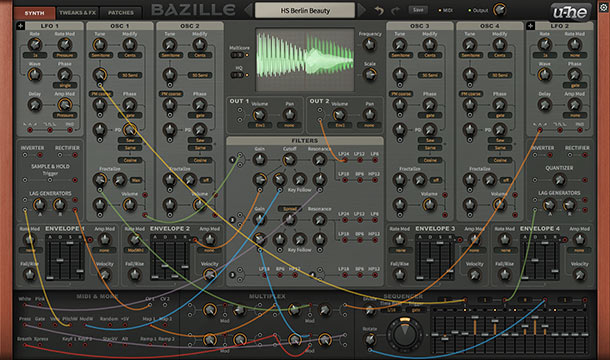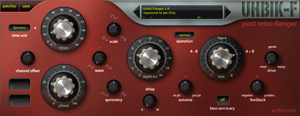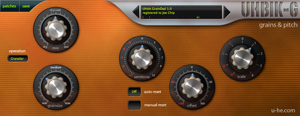ACE (Any Cable Everywhere) 屬於新一代音效合成器軟體,是同類產品當中發展最新、最快的。
ACE是結構簡單的半模組合成器,有精選的模組和清晰的佈局,模組之間連線的方式是沒有任何限制的,可以從任一匯出到任一匯入更新檔。您會發現ACE比那些非模組化合成器要更好玩,ACE為新人理想的模組化合成器工具。
ACE就如同中型專業的硬體系統,有足夠的合成功能,讓您不斷發現新花樣!
ACE 可運行在 Mac 及 windows。

Full deck
The “boxes and cables” philosophy of modular synthesizers gives you the freedom to create your own custom instruments. Once you start connecting the sixteen modules in ACE—exploring new combinations, cross-pollinating ideas—the vast potential of modular soon becomes clear.
Sounds
The two VCOs act as the main sound generators, but as ACE does not differentiate between audio and control (modulation) signals, the full-range LFOs can also be used to generate audio frequencies.
ACE’s oscillators are modelled on analogue circuits, including instabilities and various  non-linear characteristics. You can push these characteristics further using the Circuit Bending options.
non-linear characteristics. You can push these characteristics further using the Circuit Bending options.
If the bottom end needs beefing up, try adding the sub-oscillator. For more intense, complex sounds, try VCO2’s ring modulation, sync and cross modulation.
The LFOs can be co-opted for sound generation. They are similar to the VCOs but have a different feature set, including the possibility of phase modulation (commonly referred to as FM synthesis) and custom waveforms (LFO2 only). Wild experimentation is welcome here—draw any waveform or use the Spectralize function to create additive waves.
Mapping Generator
Not typically found in analogue synthesizers, ACE’s Mapping Generator is a useful addition with a variety of uses. The Mapping Generator is a list of up to 128 values. You can use the drawing tools to edit the values and create your own patterns, or choose pre-built shapes. This map can be stepped through for each played note, it can create per-note offsets, it can transform any modulation source or be used as the LFO2 waveform.

Filter
Like the oscillators, the two filters are modelled on analogue hardware and deliver satisfyingly analogue results. You can overdrive the filters without introducing any harsh distortion, and the resonance remains intact. Or you can take advantage of the self-oscillation feature for chaotic timbres and more experimental sound design.
For an extra aggressive sound, route your signal through both filters and crank the resonance on the second filter. Both filters are cascade type multimode circuits with two parallel outputs each.
Cables anywhere and everywhere
ACE takes after hardware modular synthesizers, although it is not a truly modular design, more correctly it is semi-modular. ACE has a default fixed architecture (like for instance the ARP 2600), which means you can start making noise immediately ‘out-of-the-box’. Any default routing can be overridden by patching cables, which means that the options are practically limitless.
ACE does not differentiate between audio signals and control signals. Any of the outputs can be plugged into any of the signal inputs. Hook things up, explore new ideas and crazy combinations. Try LFOs as audio oscillators or a VCO as LFO. Plug an LFO into a filter, then use the filter as an FM source for an oscillator.
Sound experimentation awaits, limited only by your imagination… and dinner time.
Signal sources
An array of output sockets provide signals from a variety of different sources: noise, MIDI controls (modwheel, velocity etc.), mapping generator and more…
Use these to add organic life-like dynamics, modulation and refinments your sounds.
Effects
Add final touches using the global effects. Pick from a classic stereo chorus with four modes (including phaser) to add richness, a stereo delay with seven immediately selectable modes to add movement, and finally a pair of controls to boost treble and bass.
Ramp generator
If the two ADSRs and two LFOs are not enough, try the host-syncable Ramp Generator (essentially a trapezoid, which combines elements of both).
Multiples
Common to most modular setups, multiples are mix/split devices. Signals are merged and sent onward, or split and sent to different inputs. In ACE the multiples do act as a simple mixer, or can be enlisted for much more interesting possibilities. That is why we renamed them Multiplex. Using the modulation input and some clever cable arrangements, the Multiplex modules can do ring modulation (RM), amplitude modulation (AM) or both at the same time. Or crossfading or inversion…
Envelopes
Without envelopes, your patches would just turn on and off with each note, organ style. Envelopes add dynamics over the length of the note. ACE has classic ADSR envelopes, but with a few extras directly available for more interesting results: Snap, fall/rise, level modulation, rate modulation, velocity. The envelopes can be further with modified in the Envelope Tweaks section. Switch on the singing envelopes for classic analogue retriggering behaviour, or adjust the fall/rise limits.
- 2 x LFO (1 sine, 1 sine/tri/saw/sqr) 0Hz - 20kHz.
- 2 x ADSR (same as Bazille).
- 2 x VCO (saw/PWM) 0Hz - 20kHz, VCO1 with SubOsc.
- 2 x VCF (two variable outlets each: LP1/LP2/LP3/LP4, HP/BP/BR).
- 2 x VCA/Pan.
- 2 x Multiples (as in Bazille).
- 1 x Mixer (Osc balance, Sub, Noise, Aux).
- 1 x Ramp Generator (up->hold->down->rest, loops if rest < 100).
- 1 x Mapping Generator (creates variable values for each note or key, can be used as custom waveform for LFO2).
- 1 x noise (white, pink).
- 1 x the common extras, such as Glide/Glide2.
- 1 x stereo chorus (global).
- 1 x ping pong delay (global).
- 1 x Bass/Treble booster (global).
25 signal sources, 30+ signal targets, some paths wired internally so that it makes noise even without a single cable attached (think ARP 2600). 100% free of Supersaw. Instead it has:
- Exceptional sync /w FM (VCO1->VCO2, think Cross-modulation).
- LFOs that can be used as additional VCOs and vice versa.
- Exceptional filter sound including convincing self oscillation.
- Multichannel MIDI support.
- Support for .tun files.
- 800+ presets, including banks by Howard Scarr and Skippy Lehmkuhl.
- User interface zooms in 10% steps (70-200%).
- Configuration menu to set preferences and assign MIDI controls.
- Support for Oddsound MTS-ESP
編曲實例
ACE 介面介紹
影片教學介紹
Part 1
Part 2
Part 3
Part 4
System Requirements
- Mac OS X 10.5 or newer
- Windows XP/Vista or newer
- Linux
- 1GB RAM, more recommended
- 50MB free disk space
- 1000 × 600 or larger display
- Modern CPU (Sandy Bridge or newer recommended)
- Host software
ZEBRA
無線模組化合成器。集結加、減法的合成技術,以功能強大的調變引擎透過內建效果片產生非常平順的音質。
還加入了音速般的頻率調變功能、自然界聲音模組、以及高階波表合成器等等。
 a
a
Diva The spirit of analogue
怪獸級的合成器音源-->真實的模擬聲音。
Diva 的 Oscillator, Filter 和 Envelope 都模擬了過去許多經典合成器的音色和特色,透過不同的交互使用 Diva 可以創造出很類似於類比的音色。
雖然 Diva 相當耗費 CPU 資源,但是它音色是使用即時的電路模擬方式產生(像電路模擬軟體 PSpice 一樣)並降低延遲的問題,用 CPU 資源換得零延遲應該是相當值得的。

Bazille Modular Synthesizer
The second spawn of the Berlin Modular project, Bazille is a large polyphonic modular system with digital (PD, FM based) oscillators, multimode filters and plenty of modulation options. With so much connectivity to explore, patching in Bazille should keep you fascinated for many years – it’s definitely a “geek machine”!

Repro Two classics, recreated
Repro dives into the past for analogue inspiration, meticulously modelling two famous synthesizers. Every detail of the original was captured using component-level modelling technology to create the most authentic model possible. All the subtle characteristics and quirks found in the originals are present in Repro. One product, one installer, two synths.

Hive Sleek, streamlined, fast

BazilleCM Little modular monster

ZebraCM Baby zebra

TyrellN6 A compact, sporty synth

Effects
- Colour Copy Bucket Brigade Delay
- Presswerk Compression with musical soul
- Satin Tape simulation
- Uhbik Nine subtle to spectacular effects
- Filterscape Sound mangling and filtering
- MFM2 Delay heaven
- Protoverb Experimental research reverb
.png)

多通道效果器套装軟體
共9種如下:

While most of the other effects in the Uhbik family are geared towards the more synthetic, radical effects, Uhbik-A is the master of understatement. Great reverb is seldom conspicuous, but if itʼs not there, something is missing from the sound. With its independant control over high and low-frequency decays, diffusion and modulation, Uhbik-A delivers the kind of reverberations that can turn a flat sound into a warm space, or evoke the widest of landscapes!
.jpg)
Imagine an echo that repeats every quarter note, although precise quarters are not part of the echo signal? Or ping-pong delay (no central tap) that applies the Haas effect for extra movement? Or 7.1 surround delays… Uhbik can do all this and more – once again, the simplicity of the GUI belies its power. Uhbik-D is the perfect playground for creative delays without the overt complexity of MFM2 (see there!)

Uhbik-F simulates two tape machines per audio channel, with recording and playback heads that can even occupy the same position if you want – impossible in the real world! Bass frequencies can bypass the effect ('bass sanctuary') to ensure LF-stability while the rest of the sound is swept around. Turn up the drive (2nd harmonic distortion), and your lead line will scorch its way through any mix!

Effectively cuts audio material into snippets ('grains'), then plays them back at a variable rate – even backwards. In the original tape devices, the radius of a rotating cylindrical tape-head determined grain size and the length of tape in contact with the cylinder determined the overlap between grains. But Uhbik-G is not bound by the physical limitations of rotating cylinders – you can make it huge or impossibly small!
.jpg)
Again, bass frequencies can bypass the effect ('bass sanctuary') to ensure LF-stability. Again, resonance accentuates the comb filter effect, but unlike Uhbik-F the distance between peaks is kept fairly constant. As the signal is phase-shifted each time it is fed back, frequencies are created that were not present in the original signal – the main reason why Uhbik-P is also great for wild metallic effects!

Maximum flexibility from a minimum of controls, low CPU without compromising transparency. Uhbik-Q combines freely tunable frequency bands (4-pole filters, not the usual 2-pole!) with presets for other options. Q-factors automatically adjust to gain, an optional 'mid' bell curve filter adjusts to the two main bands… judging by the simple GUI, you would never guess just how much this EQ can do!
 Runciter
Runciter
filter with parallel lowpass, bandpass and highpass outputs, resonance, controllable input overdrive and brick-wall fuzz.
Filters were always dramatic sound-shaping tools, one reason why they’re still so popular. But users today expect more than a simple resonant lowpass, so here's RUNCITER! For classic wah-wah, add low- and highpass together then control cutoff from a MIDI pedal. Or max out the resonance and drive the input from -48db to 48dB for a vast range of effects... instant glittering sweeps or absolute filter mayhem!

frequency shifter / sideband filter with exceptional frequency response and low latency, can create anything from serene barber-pole waves to metallic FFF (full frequency freakout) effects!
Movement in frequency shifters (no LFO required) is constantly downwards or upwards. In Uhbik-S, the barber-pole effect can even rise in one channel while falling in the other. Clever routines prevent otherwise inaudible sidebands from folding back into the audio range – Uhbik-S never compromises audio quality.
 Uhbik-T
Uhbik-T
tremolo – but if you think that just means 'volume wobble' you haven't tried the mother of all tremolos yet: Uhbik-T!
Our tremolo unit Uhbik-T is a general-purpose 'rhythmicizer' featuring linear or exponential (with 3 different strengths) gain modulation. But there's much more: You can morph between user-defined patterns in the 11 x 16 grid, apply rhythmic lowpass filtering, add vibrato or Haas-delay spatial effects. In either of the pattern modes, the LFO wave knob selects a position between 11 user-defined patterns, and the LFO scale knob determines precisely how 'choppy' the effect is... tremolo redefined!


